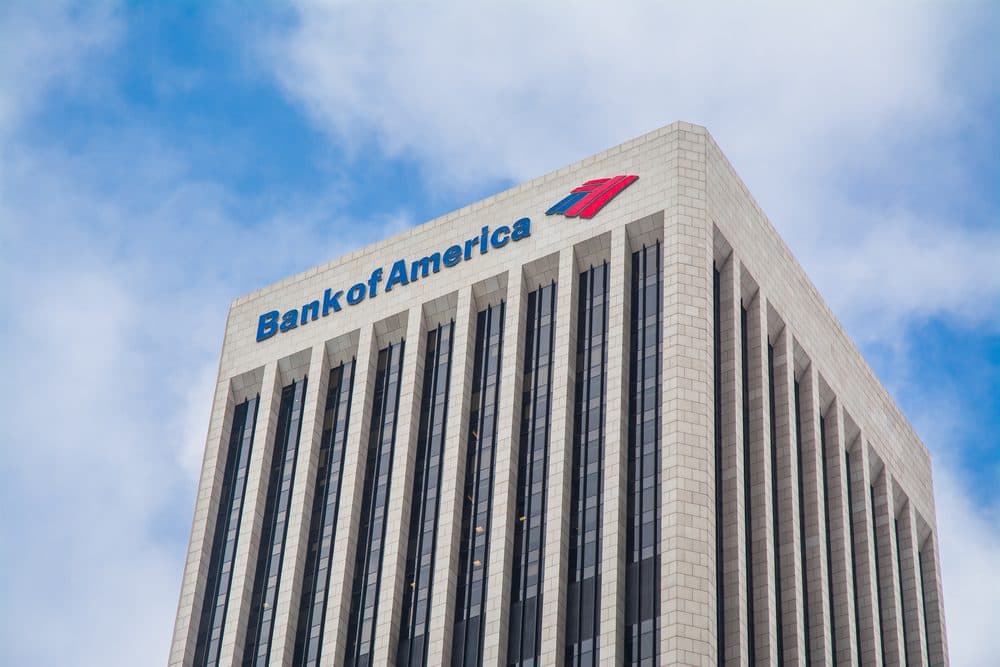Bank of America is Bullish on Digital Assets; Believes Bitcoin is Only the Beginning
The market capitalization of digital assets, now sitting at over $2 trillion, surpasses the GDP of many countries. It is a blossoming asset class that has become too large to ignore, according to new Bank of America report.

A Bank of America tower in Los Angeles (Source: Shutterstock)
- Bank of America (BoA) kicked off its digital asset research division with an in-depth report titled ‘Digital Assets Primer: Only the first inning’ led by Alkesh Shah
- While BoA believes Bitcoin is important, they think that the digital asset ecosystem as a whole has the chance to disrupt finance, technology, supply chains, social media, gaming, and more
Bank of America officially launched its cryptocurrency research division with a new 140-page report titled, “Digital Assets Primer: Only the first inning,’ that covers bitcoin, NFTs, DeFi, central bank digital currencies (CBDCs) and more.
Led by Alkesh Shah, head of global cryptocurrency and digital asset strategy, the report reveals that 221 million people have purchased or sold a cryptocurrency as of June 2021, up from 66 million in May 2020.
“It’s difficult to overstate how transformative blockchain technology, digital assets and the thousands of decentralized apps that have yet to be created could potentially be,” the report states.
Going beyond bitcoin
Up until today, Bank of America’s attention was primarily focused on bitcoin and bitcoin futures trading. However, its new report suggests that the bank is looking into all aspects of the digital assets industry. “Digital assets that enable a platform to be built, like the Apple iPhone did for applications, are gaining the most value; the top three: ether (365% ytd to $403bn value), cardano (1427% ytd to $89bn value) and binance coin (1142% ytd to $78bn value)”.
The report also cites the increasing relevance of stablecoins and the potential of CBDCs. The top six stablecoins by market capitalization have reached a combined value of $115 billion and settled $2.8 trillion of transactions in the first half of 2021, according to the report.
The worry amongst policy makers is that private stablecoins could create systemic risk if there were ever a ‘bank run’ type situation, according to the report. It would force the issuers to liquidate their collateral and cause contagion effects in traditional financial markets. Some issuers — notably Tether Limited — hold commercial paper in order to generate a yield on reserves, and if they grew too large, sudden redemption demand might prompt them to try to liquidate their commercial paper holdings, which could have massive ramifications in the corporate bond market.
CBDCs: When, not if
According to the report, the bank believes that CBDCs are a question of “when”, not “if”.
Governments and regulators globally have stepped up efforts to limit usage of digital assets, as adoption and use have increased. Some of the key issues that governments and regulators appear to be focused on revolve around AML/KYC, mitigating potential bank runs, taxation and liability. A central bank-issued/managed CBDC would address these issues, while maintaining central bank monetary policy control” according to the report.
Bank of America has also kept their eye on non-fungible tokens (NFTs). While they do credit the current methods of utilization for art and gaming in the research piece, they also recognize other potential use-cases. “NFTs can be used instead of deeds, titles or anything currently needed to demonstrate ownership — and all without a middleman charging a fee,” the company report stated.
Referring to the focus on NFTs in the report, Anto Paroian, chief operating officer at crypto/digital assets hedge fund ARK36, said, “The most interesting thing to note is that the [report] explicitly mentions NFTs as one of the current drivers of the digital asset market.” He continued:
“Although there are many voices dismissive of the NFT ecosystem as just another bubble, non-fungible tokens are already a massive economy. Bank of America seems to be well aware that NFT’s disruptive potential will spill over to other industries and extend well beyond this current bull market.”
The DeFi threat
Perhaps the greatest threat to Bank of America’s business model is decentralized finance (DeFi), where users can carry out many of the functions of a traditional bank such as borrowing, lending, earning attractive yields and many other activities.
Contrary to expectations of apprehension toward embracing DeFi, the report sounds optomistic about its future:
“The SEC is investigating DeFi applications and companies to determine if and how they should bring them into the current regulatory framework. We are optimistic about the long-term growth of this segment as it matures and regulatory uncertainty is clarified.”
Throughout the report, Bank of America stresses that the main headwind for growth in the near-term is regulatory risk. But they also state that in the long-run, clarity from regulators will allow new entrants to participate in the emerging asset class.
Are you a UK or EU reader that can’t get enough investor-focused content on digital assets? Join us in London on November 15th and 16th for the Digital Asset Summit (DAS) London. Use code ARTICLE for £75 off your ticket. Buy it now.






